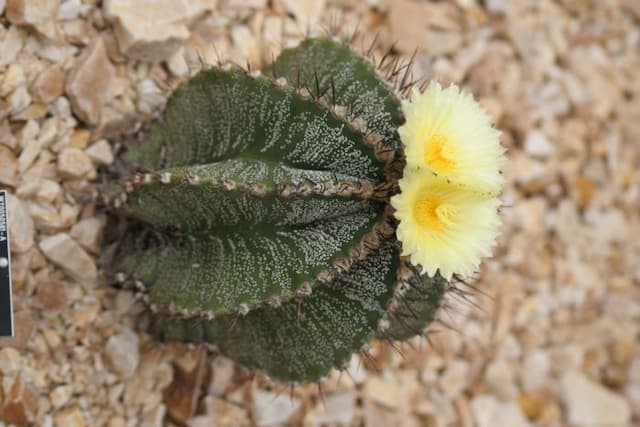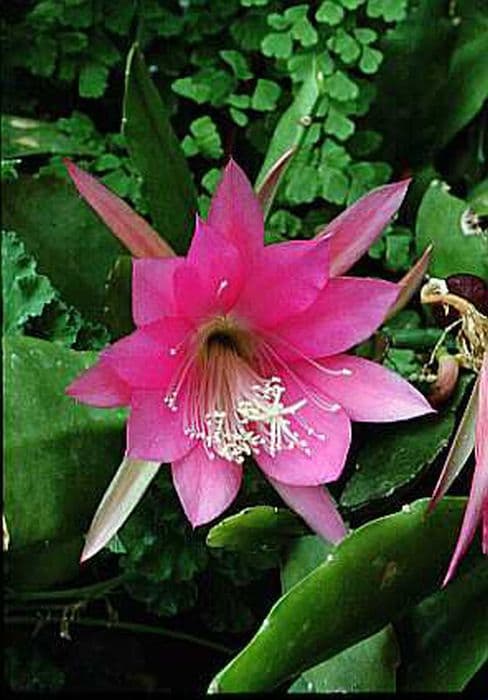Balloon Cactus Parodia magnifica

ABOUT
The Balloon cactus is a species that is distinct in its appearance, characterized by its spherical to elongated shape. This plant is typically green and has a glossy texture on its surface. It is covered in pronounced ribs that run vertically from the top to the bottom of the plant body. Growing from these ribs, you'll find evenly spaced clusters of spines. These spines are firm and needle-like, radiating out from the cactus in a star-like pattern. The spines can come in various colors, ranging from yellow to a reddish shade, providing a striking contrast against the green body of the cactus. As the Balloon cactus matures, it may produce flowers that are generally yellow, adding another layer of beauty to its appearance. These flowers can be quite showy and often form a ring around the top of the plant, resembling a crown. After flowering, the plant may also develop small, bulbous fruit that carries seeds for reproduction. The overall impression of the Balloon cactus is one of hardiness and beauty, often admired by those who appreciate unique and resilient plants.
About this plant
 Names
NamesFamily
Cactaceae.
Synonyms
Balloon Cactus, Blue Ball Cactus, Magnificent Ball Cactus, Green Ball Cactus.
Common names
Notocactus magnificus, Eriocactus magnificus, Malacocarpus magnificus.
 Toxicity
ToxicityTo humans
The Balloon Cactus (Parodia magnifica) is not known to be toxic to humans. There are no significant toxic effects reported from ingesting this plant.
To pets
The Balloon Cactus (Parodia magnifica) is also not known to be toxic to pets. Ingesting this plant should not cause any significant poisoning or toxic symptoms in animals.
 Characteristics
CharacteristicsLife cycle
Perennials
Foliage type
Evergreen
Color of leaves
Green
Flower color
Yellow
Height
1 foot (30 cm)
Spread
6 inches (15 cm)
Plant type
Cactus
Hardiness zones
9
Native area
South America
Benefits
 General Benefits
General Benefits- Low Maintenance: The Parodia magnifica, also known as the Ball Cactus, is known for its ease of care, making it ideal for novice gardeners or those with a busy lifestyle.
- Aesthetic Appeal: With its ribbed texture and bright yellow flowers, the Ball Cactus adds a touch of exotic beauty to any indoor or outdoor setting.
- Drought Tolerant: Adapted to arid environments, this cactus is highly drought-resistant and requires infrequent watering, saving on water resources.
- Long Living: The Ball Cactus is known for its longevity, meaning it can be a long-term companion in your home or garden.
- Small Space Gardening: Its compact size makes the Ball Cactus an excellent choice for those with limited space, such as apartment dwellers.
- Educational Value: Growing a Ball Cactus can be an educational experience, teaching about plant care, desert flora, and the adaptation mechanisms of succulents.
 Medical Properties
Medical PropertiesThis plant is not used for medical purposes.
 Air-purifying Qualities
Air-purifying QualitiesThis plant is not specifically known for air purifying qualities.
 Other Uses
Other Uses- Parodia magnifica, also known as the Ball Cactus, can be used as a natural barrier when planted in dense groups because of their spines, which can deter animals and unauthorized entry into private areas.
- The unique spherical shape and spiky appearance of the Ball Cactus make it an excellent choice for artistic and ornamental displays in garden design, providing strong visual interest.
- In educational settings, the Ball Cactus can be utilized to teach botany and plant physiology, making it a practical tool for hands-on learning about cacti and their adaptations.
- The Ball Cactus can be employed in the creation of miniature gardens or terrariums, creating desert landscapes within small glass containers.
- This plant can be used in feng shui practice as an element that adds ‘fire’ energy to a space, reportedly bringing positive energy when placed in the right location.
- The slow-growing nature of the Ball Cactus makes it a suitable plant for long-term research projects studying growth patterns and environmental effects on plant development.
- As a natural insulator, the Ball Cactus might be investigated for its potential use in sustainable building designs that incorporate living plants.
- Photographers and artists may use the Ball Cactus as a subject for still life images and paintings, capturing the intricate details and patterns of this succulent.
- The Ball Cactus can serve as a tool for psychological research on the effects of nurturing plants on human well-being, due to its easy-care nature and longevity.
- In regions where the Ball Cactus is native, it can be used as an indicator species for ecological studies, helping researchers assess the health of the ecosystem.
Interesting Facts
 Feng Shui
Feng ShuiThe Balloon Cactus is not used in Feng Shui practice.
 Zodiac Sign Compitability
Zodiac Sign CompitabilityThe Balloon Cactus is not used in astrology practice.
 Plant Symbolism
Plant Symbolism- Resilience: The Parodia magnifica, commonly known as the Balloon Cactus, is able to thrive in harsh, dry environments, symbolizing the ability to endure and overcome difficult conditions.
- Longevity: With its potential for a long lifespan, the Balloon Cactus represents long life and timelessness.
- Independence: As a cactus that requires minimal water and care, it stands for self-sufficiency and independence.
- Protection: The spines of the Balloon Cactus serve as a natural defense system, symbolizing protection and personal boundaries.
- Adaptability: Its capability to adapt to various light and temperature conditions represents flexibility and adaptability in life.
 Water
WaterThe Parodia magnifica, commonly known as the Balloon Cactus, should be watered thoroughly, allowing the water to soak through to the root level; however, it is crucial to let the soil completely dry out between waterings. In the active growing season, which is usually from spring to fall, water approximately every two weeks, providing around 8-16 ounces depending on the size of the pot and the plant. During winter, reduce watering to once a month or less, closely monitoring the soil moisture to prevent root rot. It's important to avoid overhead watering to reduce the risk of fungal diseases.
 Light
LightThe Balloon Cactus thrives in bright, indirect sunlight, making it ideal for east or west-facing windowsills where it can receive ample light without the harshness of midday sun. Direct sunlight can be given but should be limited to avoid scorching the plant. It can also flourish under bright artificial lighting, which makes it suitable for office environments with less natural light.
 Temperature
TemperatureThe Balloon Cactus prefers warm temperatures and does well in a typical room temperature range between 70°F and 80°F. It's important to keep it away from drafts and colder areas, as low temperatures can damage the plant. The Balloon Cactus can tolerate a minimum temperature of around 50°F, but temperatures below this may lead to cold damage.
 Pruning
PruningPruning is not typically required for the Balloon Cactus, as it naturally maintains a compact shape. However, any dead or damaged spines can be gently removed to maintain its appearance. If necessary, the best time for this limited pruning would be in the active growing season, allowing the plant to heal quickly.
 Cleaning
CleaningAs needed
 Soil
SoilThe Balloon Cactus needs a well-draining cactus mix with a slightly acidic to neutral pH of 6.0 to 7.5. A blend of perlite, sand, and peat-based compost is ideal to ensure adequate drainage and aeration for the roots. Adding some fine gravel or pumice can enhance drainage further, which is crucial to prevent root rot in this cactus species.
 Repotting
RepottingThe Balloon Cactus should be repotted every 2 to 3 years, or when it has outgrown its current pot. Best done in springtime, choose a container only slightly larger than the previous one to prevent excess soil moisture, which could potentially harm the plant.
 Humidity & Misting
Humidity & MistingThe Balloon Cactus prefers low to moderate humidity levels, typical of arid environments. It thrives under indoor conditions where the humidity is usually lower than outdoors. Excessively high humidity can increase the risk of fungal diseases for this cactus.
 Suitable locations
Suitable locationsIndoor
Place Balloon Cactus near a sunny window; water sparingly.
Outdoor
Plant in full sun, protect from heavy rain and frost.
Hardiness zone
9-11 USDA
 Life cycle
Life cycleParodia magnifica, commonly known as Ball Cactus, begins its life as a seed, typically germinating in warm, moist soil conditions. In the seedling stage, it develops a small, rounded body and a root system, gradually producing spines and photosynthetic tissue. As it matures into a juvenile cactus, the Parodia magnifica grows slowly, forming a characteristic globe shape and beginning to exhibit ribbed segments. Reaching adulthood, the cactus increases in girth and may produce offsets or "pups" around its base, which contribute to asexual propagation. The adult Ball Cactus blooms in the summer with striking yellow flowers from the crown, leading to pollination and seed set if successfully pollinated by insects or other means. At the end of its long life, which can be several decades, the plant eventually senesces and dies back, leaving seeds to continue the species' lifecycle.
 Propogation
PropogationPropogation time
Spring to Summer
The Ball Cactus, more scientifically known as Parodia magnifica, is a plant that is typically propagated through the sowing of seeds. The optimal time for propagation is during the spring to early summer when temperatures are warm, which facilitates germination. To propagate by seeds, one would prepare a pot with a well-draining soil mix, then sprinkle the seeds evenly over the surface. After lightly covering the seeds with a thin layer of soil or sand, the pot should be kept in a warm place with indirect light and the soil should be kept moist but not waterlogged. Germination can take several weeks, and once seedlings appear, they need to be carefully watered and eventually, as they grow, transplanted into individual pots. This seed propagation method is popular because it can produce a large number of new plants, although it requires patience as cacti grow relatively slowly.









